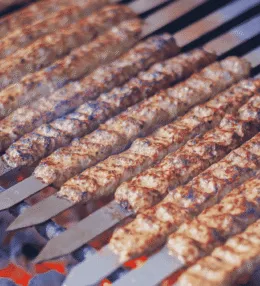
- View
Table of Contents
ToggleAlheira is not your typical sausage. It looks familiar on the plate but carries with it a story that makes each bite more meaningful. Found throughout northern Portugal, this smoked sausage is rustic, smoky, and unmistakably rich in both flavour and history.
Often served with a fried egg and chips, it is the kind of dish that manages to feel hearty and humble at the same time. The outer skin crisps up beautifully when fried, while the inside stays soft and deeply savoury.
For many in Portugal, Alheira is a taste of home. It is not just about the ingredients. It is about where it comes from, how it came to be, and the way it has been quietly passed through generations.
Want to dive deeper into Portuguese Cuisine? Don’t miss our post on 38 Traditional Portuguese Foods to Try
What Is Alheira?
Alheira is a smoked sausage typically made from a mix of bread, garlic, olive oil, and meat such as poultry or game. It is shaped into a horseshoe, lightly smoked, and usually fried or grilled rather than boiled or steamed.
What makes Alheira distinct is its bread content. Unlike most sausages which are mostly meat, Alheira uses bread as a filler. This gives it a softer, more delicate texture, almost like a stuffing encased in a sausage skin.
It is typically served as part of a larger plate, often with fried eggs and potatoes, though it also holds its own as a standalone bite. It is savoury, rich, and deeply satisfying without being heavy or greasy.
Ingredients and Taste
Traditional Alheira uses a mix of meats, most commonly chicken or duck, combined with day-old bread, garlic, olive oil, and spices. The mixture is ground together, stuffed into a casing, and then smoked over wood.
The result is a sausage that tastes smoky and earthy, but also surprisingly light. The bread softens the meatiness, giving it a balanced flavour. Garlic plays a leading role without overpowering, while the smoke lingers gently.
When fried, the outer layer turns golden and crisp. The filling stays soft and slightly crumbly. It is not a dense sausage. Instead, it is textured and flavourful, perfect for soaking up runny egg yolk or pairing with pickled vegetables.
A Taste of History
Alheira’s origin is rooted in both resilience and creativity. It was created by Portuguese Jews during the Inquisition to appear Christian. At a time when avoiding pork could arouse suspicion, Alheira helped them blend in.
By using poultry and bread instead of pork, they mimicked the look of traditional sausages. Smoked and hung like any other, it allowed them to maintain appearances while preserving their dietary laws.
Over time, Alheira became a beloved dish beyond its hidden beginnings. It moved from a tool of survival to a symbol of culinary invention. Today, it is enjoyed for its taste, but the story behind it still holds weight.
It serves as a quiet reminder of Portugal’s layered past. Eating Alheira is not just about flavour. It is about understanding how food adapts to history. It is a dish born from necessity yet now celebrated with pride across the country.
How to Make Alheira (Portuguese Smoked Sausage)
Alheira is a traditional Portuguese sausage born out of creativity and resistance. Originally made by Jews avoiding persecution, it uses bread instead of pork fat and blends smoked meats, garlic, and paprika into a rich, garlicky filling. Expect a smoky, savoury sausage with a crisp exterior and soft, flavour packed interior. This version captures its rustic soul while guiding you through its careful preparation. See the recipe card at the bottom for printable directions
Ingredients
For the filling
- 500g cooked chicken or duck meat (shredded)
- 250g cured meat (such as smoked sausage or chouriço), finely chopped
- 200g rustic day-old bread (soaked in water and squeezed)
- 6 garlic cloves, minced
- 1 tbsp sweet paprika
- 1 tsp hot paprika
- 1 tsp white pepper
- 1 tsp ground cumin
- 60ml olive oil
- Salt to taste
For casing and smoking
- Natural sausage casings (hog or sheep)
- Wood chips (olive wood or oak preferred)
Cooking Instructions
Step 1: Prepare the bread
To begin, tear the bread into chunks, soak in water until soft, then squeeze out the excess moisture. Set the moistened bread aside. Transition to preparing the meat blend.
Step 2: Combine the meats
In a large mixing bowl, combine the shredded cooked poultry and chopped cured meat. Use your hands or a sturdy spoon to mix thoroughly. Proceed to spice blending.
Step 3: Add garlic and spices
Mix in minced garlic, both paprikas, cumin, white pepper, and a generous pinch of salt. Pour in the olive oil and stir until the spices coat the meat evenly. Add the soaked bread.
Step 4: Incorporate the bread
Fold in the moistened bread until fully blended. The texture should be soft but cohesive, almost like a thick paste. Adjust seasoning if needed. Move to casing preparation.
Step 5: Prepare the sausage casings
Rinse the natural casings under cold water, then soak them in warm water for 20–30 minutes. Flush them with clean water to remove any salt. Transition to stuffing the sausages.
Step 6: Stuff the sausages
Using a sausage stuffer or piping bag, fill the casings with the mixture, ensuring there are no air pockets. Twist into 15–20cm links. Tie both ends securely. Move on to drying.
Step 7: Air dry the sausages
Hang the sausages in a cool, dry place for 24–48 hours to firm up and develop initial flavour. Ensure good airflow. Proceed to cold smoking.
Step 8: Smoke the sausages
Cold smoke the sausages for 2 to 3 hours using olive wood or oak chips. Keep temperature below 30°C. This stage adds depth and authenticity. Transition to cooking before serving.
Step 9: Pan fry the sausages
Heat a skillet over medium heat with a drizzle of olive oil. Fry the alheiras until golden and crisp on all sides, about 5–7 minutes. Avoid overcooking, as they can burst. Get ready to serve.
Final Step: Serve with traditional sides
Serve hot with sautéed greens, boiled potatoes, or a fried egg on top. A spoonful of mustard or pickled vegetables complements the richness beautifully. For true authenticity, plate with care and simplicity.
Variations and Substitutions
- Bread: Use rustic sourdough or baguette if Portuguese broa is unavailable.
- Cured meat: Replace Portuguese chouriço with Spanish chorizo or smoked kielbasa.
- Smoker alternative: If no smoker, bake at low temperature (90°C) with a smoking tray or wood chip foil packet.
- No casing? Shape into logs and wrap tightly in cheesecloth, then steam and pan fry.
Cooking Tips for Perfect Alheira
- Use day-old bread for better texture and absorption.
- Do not overfill the sausage casings to prevent bursting.
- Let the filling sit overnight for deeper flavour before stuffing.
- Cold smoking is key to authenticity, but you can replicate the flavour using smoked paprika and slow oven drying.
- When frying, prick the sausage lightly to release steam and prevent splitting.

Portuguese Alheira (Smoked Sausage)
Ingredients
For the filling
- 500 g cooked chicken or duck meat shredded
- 250 g cured meat such as smoked sausage or chouriço, finely chopped
- 200 g rustic day-old bread soaked in water and squeezed
- 6 garlic cloves minced
- 1 tbsp sweet paprika
- 1 tsp hot paprika
- 1 tsp white pepper
- 1 tsp ground cumin
- 60 ml olive oil
- Salt to taste
For casing and smoking
- Natural sausage casings hog or sheep
- Wood chips olive wood or oak preferred
Instructions
- To begin, tear the bread into chunks, soak in water until soft, then squeeze out the excess moisture. Set the moistened bread aside. Transition to preparing the meat blend.
- In a large mixing bowl, combine the shredded cooked poultry and chopped cured meat. Use your hands or a sturdy spoon to mix thoroughly. Proceed to spice blending.
- Mix in minced garlic, both paprikas, cumin, white pepper, and a generous pinch of salt. Pour in the olive oil and stir until the spices coat the meat evenly. Add the soaked bread.
- Fold in the moistened bread until fully blended. The texture should be soft but cohesive, almost like a thick paste. Adjust seasoning if needed. Move to casing preparation.
- Rinse the natural casings under cold water, then soak them in warm water for 20–30 minutes. Flush them with clean water to remove any salt. Transition to stuffing the sausages.
- Using a sausage stuffer or piping bag, fill the casings with the mixture, ensuring there are no air pockets. Twist into 15–20cm links. Tie both ends securely. Move on to drying.
- Hang the sausages in a cool, dry place for 24–48 hours to firm up and develop initial flavour. Ensure good airflow. Proceed to cold smoking.
- Cold smoke the sausages for 2 to 3 hours using olive wood or oak chips. Keep temperature below 30°C. This stage adds depth and authenticity. Transition to cooking before serving.
- Heat a skillet over medium heat with a drizzle of olive oil. Fry the alheiras until golden and crisp on all sides, about 5–7 minutes. Avoid overcooking, as they can burst. Get ready to serve.
- Serve hot with sautéed greens, boiled potatoes, or a fried egg on top. A spoonful of mustard or pickled vegetables complements the richness beautifully. For true authenticity, plate with care and simplicity.
Nutrition
You May Also Like







Leave a Review